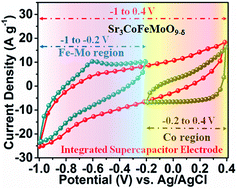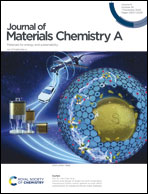Triple perovskite oxide as an advanced pseudocapacitive material: multifarious element approach with an ordered structure†
Abstract
High capacitance and large potential window are prerequisites for high energy density aqueous supercapacitors. To accomplish this, an integrated electrode based on a multifarious element approach that offers a combination of positive and negative redox potential metals in one electrode is most appropriate. With the requisite virtues, a triple perovskite is perfect for this approach in which different permutations of redox active metals can be adopted. In this work, an ordered triple perovskite Sr3CoFeMoO9−δ is synthesized as a thin sheet structure using positive (Co) and negative redox potential (Fe and Mo) metals. This not only results in capacitance enhancement, but also enlarges the working potential window via the influence of the negative inductive effect of Fe. In addition, the presence of oxygen vacancies in the thin sheet structure promotes anion pseudocapacitive charge storage through high oxygen anion diffusion. The obtained gravimetric capacitance of Sr3CoFeMoO9−δ‖Sr3CoFeMoO9−δ is 232.8 F g−1@2.5 A g−1 with a large energy density of 58.5 W h kg−1@1412.9 W kg−1. Furthermore, the thin sheet structure endows Sr3CoFeMoO9−δ with a large surface area (23.4 m2 g−1) which results in the generation of more active sites for charge storage. The above findings suggest that triple perovskites present an innovative break for the synthesis of advanced energy storage materials.

- This article is part of the themed collection: #RSCPoster Twitter Conference


 Please wait while we load your content...
Please wait while we load your content...